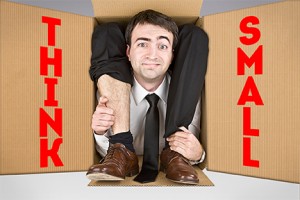From time to time GovEvents will come across information we feel our members and audience would benefit from. Here's something we wanted to share:
 Originally posted on EventManagerBlog.com
Originally posted on EventManagerBlog.com
Everyone wants to plan and produce mega-events with thousands of attendees, massive general sessions and hundreds of workshops and seminars. Yet the reality is that the vast majority of events are smaller ones, with an average audience of 100 people or fewer.
That makes generating a high attendance rate even more critical. Whether it's a seminar, a meeting or a business workshop, you want to attract as many people as possible and avoid conspicuously empty seats. But getting people to attend a smaller event can be tough. In my years of experience, I've come to this startling realization:
It's easier to get 3,000 people to register for a conference than 100 people for a seminar.
Smaller events are challenging because you have limited budget, resources and space. On the plus side, smaller events have an air of exclusivity and can be more specialized and results-driven.
So how do you increase attendance at your next event without blowing the budget and going crazy? Here are some smart, new tips and ideas for thinking big about smaller events.
Don't Book a Venue and Set a Date - Yet
I know that most people select the venue and date first. But with smaller events, the big problem is that you immediately paint yourself into a corner. You don't know who will attend, how many will attend or even why they will attend, yet you've made financial commitments and started spending money.
So let's change the way you plan your event. Before you invest your budget, invest some serious time in sharply defining your goals and expectations. These are the questions you should answer BEFORE you book a space, set a date and start marketing.
What is your event about?
What results do you want?
How long is the event?
How much space will you need to deliver the experience, content and value?
What is a realistic audience size?
Now you can rationally decide what people to invite and the type and size of space you need to book. This info is key. Big events can afford to be a little off on their audience expectations. But with smaller events, 10 people can make the difference between breaking even and losing money.
Develop Valuable Topics and Content for the Select Few
Instead of broadening your content to one-size-fits-all you need to laser-focus your content on your smaller audience. All of the marketing in the world won't make a difference if it's apparent that your event is going to plough the same old ground.
You'll also need more than one speaker who can help sell your day. In smaller events, virtually every speaker is a headliner, so look for several people with something new to say. In my experience, your best choices are not speakers who specialize in keynote presentations to large groups. Look for marketable speakers who are creditable, personable and relate well in a more intimate setting.
Fill the Seats With the Right People
Of course, you're looking for more than just a head count - you want the Right People attend. The "Right People" are influential individuals who are actively interested and engaged right now or could become clients or customers in the future.
You can find the Right People by segmenting your potential audience. It's a simple strategy.
A. Define the specific people you want to attend by:
• Job function or responsibility
• Brand or department
• Location
• Needs
• Expectations
• Obstacles
• Experience level
• Skill level
B. Break this audience down into 3-4 groups. Think strategically. Look for the logical divisions - executives, directors, managers, marketing, sales, support, etc.
C. Decide the best ways to contact and market to each group. You'll quickly discover that there are smaller channels that are more focused on specific people. Inside tip: Look for common interests beyond the obvious ones.
Ready, Steady, Market!
I'm sure you understand the basics: Your event materials and website should focus on the value and benefits first and not the location and date. Tie everything to the event "promise" you make to your target audience. Here's one of my favorite approaches for your event promise that you can carry over in your marketing and invitations. I call it "Your World Will Change."
Simply develop and communicate 3-4 strong benefit statements for each of your target audience groups. These statements highlight how your event will change their world.
Meet and discuss your business with top leaders.
Jump-start solutions with people who share similar challenges.
Share your ideas and learn new ones.
Increase your visibility and influence in the business community.
The pay off of "Your World Will Change" is that it's audience-focused. It makes you more than an event host: It makes you partners in their success.
Create an Audience Chain
If you grab only one idea from this article, this is the one. Let's say you have a typical small event with a 100-person audience. Here's a technique for filling every seat with the Right People even if your marketing budget is next to nothing.
Everyone has heard of a chain letter. So let's take the same basic principle and turn it loose on your event. I call it an Attendee Chain. Ready for this? Attendees actually invite each other!
1. Take a look at your contact list. Which 10 people would benefit from your event?
2. Invite those 10 people and ask them to invite 10 people - or to give you the names of 10 people who would benefit from the event.
3. Contact each group of friends and explain that "Victoria VP" (or whoever) gave you their name because this event meets some of their needs. Repeat the process until you have your audience.
It Works - A True Story
Here's a true story about how an Attendee Chain worked for me. The seminar was about growth strategies for marketing managers. The challenge was that we had only three weeks to attract 120 people.
Forget email! I picked up the telephone and called five business friends in office products, fast food, bedding manufacturing, real estate and hospitality. Only one was actually a marketing manager. I invited each one and then asked them to suggest other people I might contact. Each person floundered around for a minute or two and then came up with 4-5 names of other great manager prospects.
I contacted those marketing managers and explained that their friend thought they'd benefit from the event. Then I asked them for more attendee suggestions. I repeated the chain one more time. Result? We filled the audience in less than two weeks.
The power of an Attendee Chain is that it grows exponentially. I actually had to call my business friends back and ask them to stop recommending the event because we ran out of space!
Bottom line - Getting ten people to bring ten friends is much easier than getting one hundred strangers to attend.
In Conclusion
The main reason people don't register for any event is they don't understand why they should attend. The success of smaller events, in particular, depends on your ability to communicate the event's purpose, message and value. The key is to focus on the specific groups who are the most likely to attend. You don't need to shotgun email blasts to everyone - just the Right People.
Help them see you in a different way.
Tell them how their world will change and benefit after attending.
Get the event down to a personal level where attendees actually invite each other.
Use this strategy and watch your registrations soar! That's how you think big about smaller events.
 GovEvents gathers and aggregates the vast number of events geared toward the government community to create a unique and comprehensive source of intelligence. Mark Kagan has taken on an even more daunting task - collecting and synthesizing mountains of data on selected federal agencies to create unique market intelligence guides. With his company, Panoptes Intelligence, Mark is developing comprehensive guides to the "who, what, when, where, how and how much" of government agencies for government contractors. We recently sat down with Mark to learn about the guides and how they are being used in the marketplace.
GovEvents gathers and aggregates the vast number of events geared toward the government community to create a unique and comprehensive source of intelligence. Mark Kagan has taken on an even more daunting task - collecting and synthesizing mountains of data on selected federal agencies to create unique market intelligence guides. With his company, Panoptes Intelligence, Mark is developing comprehensive guides to the "who, what, when, where, how and how much" of government agencies for government contractors. We recently sat down with Mark to learn about the guides and how they are being used in the marketplace.





